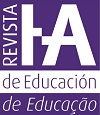O conhecimento dos estudantes do ensino fundamental I sobre funções vitais de animais e plantas
DOI:
https://doi.org/10.35362/rie5931374Palavras-chave:
Formação de conceito, Funções vitais, Seres vivosResumo
Este texto trata dos aspectos práticos na formação de conceitos com crianças em faixa etária entre 7 e 11 anos de idade, na área de Ciências Naturais. Deriva de uma dissertação de mestrado que estudou a formação de conceitos de funções vitais de seres vivos numa escola cooperativista da cidade de Central (COOPEC), estado da Bahia, em 2009-2010. Em tal estudo, objetivamos identificar os conhecimentos dos alunos acerca dos referidos conteúdos e descrever os processos que eles usam para compreendê-los. Realizamos entrevistas com os estudantes a fim de obter informações sobre o conhecimento espontâneo/científico dos estudantes com respeito aos seres vivos. A análise de dados, a partir das suas respostas, foi realizada em todas as séries com base no método comparativo, com o intuito de evidenciar o que as crianças conhecem sobre as funções vitais de seres vivos na perspectiva de mediação destes saberes para o ensino. As crianças do 2º e 3º ano mostraram conhecimento espontâneo, enquanto as do 4º e 5º ano sinalizaram a formação de conhecimento científico a partir de conhecimentos espontâneos mais elaborados. Discutimos tais conteúdos com base no conhecimento biológico da criança nos níveis espontâneo e científico.
Downloads
Como Citar
Downloads
Publicado
Edição
Secção
Licença
Os(as) autores(as) que publiquem nesta revista concordam com os seguintes termos:















